Top 10 Carnivores in Canada
The Top Ten
1 Polar Bear
 The polar bear is a carnivorous bear whose native range lies largely within the Arctic Circle, encompassing the Arctic Ocean, its surrounding seas and surrounding land masses.
The polar bear is a carnivorous bear whose native range lies largely within the Arctic Circle, encompassing the Arctic Ocean, its surrounding seas and surrounding land masses.
 The polar bear is a carnivorous bear whose native range lies largely within the Arctic Circle, encompassing the Arctic Ocean, its surrounding seas and surrounding land masses.
The polar bear is a carnivorous bear whose native range lies largely within the Arctic Circle, encompassing the Arctic Ocean, its surrounding seas and surrounding land masses.
2 Killer Whale
 The Orca, or Killer Whale (Orcinus orca), is a toothed whale belonging to the oceanic dolphin family, of which it is the largest member. It is recognizable by its black-and-white patterned body. Orcas are a cosmopolitan species and can be found in all of the world's oceans, in a variety of marine environments, from Arctic and Antarctic regions to tropical seas... read more
The Orca, or Killer Whale (Orcinus orca), is a toothed whale belonging to the oceanic dolphin family, of which it is the largest member. It is recognizable by its black-and-white patterned body. Orcas are a cosmopolitan species and can be found in all of the world's oceans, in a variety of marine environments, from Arctic and Antarctic regions to tropical seas... read more
 The Orca, or Killer Whale (Orcinus orca), is a toothed whale belonging to the oceanic dolphin family, of which it is the largest member. It is recognizable by its black-and-white patterned body. Orcas are a cosmopolitan species and can be found in all of the world's oceans, in a variety of marine environments, from Arctic and Antarctic regions to tropical seas... read more
The Orca, or Killer Whale (Orcinus orca), is a toothed whale belonging to the oceanic dolphin family, of which it is the largest member. It is recognizable by its black-and-white patterned body. Orcas are a cosmopolitan species and can be found in all of the world's oceans, in a variety of marine environments, from Arctic and Antarctic regions to tropical seas... read more Also known as orca.
I've seen them performing a great live show in a theme park - Marineland (in Niagara Falls, Canada). At the end of the show they even waved goodbye with their tails.
Yes, orcas can be trained. Obviously.
3 Canada Lynx
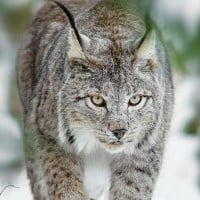 A lynx is any of the four species (the Canada lynx, Iberian lynx, Eurasian lynx, or bobcat) within the medium-sized wild cat genus Lynx. The name lynx originated in Middle English via Latin from the Greek word λύγξ, derived from the Indo-European root leuk- ('light, brightness') in reference to the luminescence of its reflective eyes.
A lynx is any of the four species (the Canada lynx, Iberian lynx, Eurasian lynx, or bobcat) within the medium-sized wild cat genus Lynx. The name lynx originated in Middle English via Latin from the Greek word λύγξ, derived from the Indo-European root leuk- ('light, brightness') in reference to the luminescence of its reflective eyes.
 A lynx is any of the four species (the Canada lynx, Iberian lynx, Eurasian lynx, or bobcat) within the medium-sized wild cat genus Lynx. The name lynx originated in Middle English via Latin from the Greek word λύγξ, derived from the Indo-European root leuk- ('light, brightness') in reference to the luminescence of its reflective eyes.
A lynx is any of the four species (the Canada lynx, Iberian lynx, Eurasian lynx, or bobcat) within the medium-sized wild cat genus Lynx. The name lynx originated in Middle English via Latin from the Greek word λύγξ, derived from the Indo-European root leuk- ('light, brightness') in reference to the luminescence of its reflective eyes. A wild cat with tufted ears
4 Great White Shark
 The great white shark (Carcharodon carcharias), also known as the white shark, white pointer, or simply great white, is a species of large mackerel shark which can be found in the coastal surface waters of all the major oceans. It is notable for its size, with larger female individuals growing to 6.1 m (20 ft) in length and 1,905–2,268 kg (4,200–5,000 lb) in weight at maturity. However, most are smaller; males measure 3.4 to 4.0 m (11 to 13 ft), and females measure 4.6 to 4.9 m (15 to 16 ft) on average. According to a 2014 study, the lifespan of great white sharks is estimated to be as long as 70 years or more, well above previous estimates, making it one of the longest lived cartilaginous ...read more.
The great white shark (Carcharodon carcharias), also known as the white shark, white pointer, or simply great white, is a species of large mackerel shark which can be found in the coastal surface waters of all the major oceans. It is notable for its size, with larger female individuals growing to 6.1 m (20 ft) in length and 1,905–2,268 kg (4,200–5,000 lb) in weight at maturity. However, most are smaller; males measure 3.4 to 4.0 m (11 to 13 ft), and females measure 4.6 to 4.9 m (15 to 16 ft) on average. According to a 2014 study, the lifespan of great white sharks is estimated to be as long as 70 years or more, well above previous estimates, making it one of the longest lived cartilaginous ...read more.
 The great white shark (Carcharodon carcharias), also known as the white shark, white pointer, or simply great white, is a species of large mackerel shark which can be found in the coastal surface waters of all the major oceans. It is notable for its size, with larger female individuals growing to 6.1 m (20 ft) in length and 1,905–2,268 kg (4,200–5,000 lb) in weight at maturity. However, most are smaller; males measure 3.4 to 4.0 m (11 to 13 ft), and females measure 4.6 to 4.9 m (15 to 16 ft) on average. According to a 2014 study, the lifespan of great white sharks is estimated to be as long as 70 years or more, well above previous estimates, making it one of the longest lived cartilaginous ...read more.
The great white shark (Carcharodon carcharias), also known as the white shark, white pointer, or simply great white, is a species of large mackerel shark which can be found in the coastal surface waters of all the major oceans. It is notable for its size, with larger female individuals growing to 6.1 m (20 ft) in length and 1,905–2,268 kg (4,200–5,000 lb) in weight at maturity. However, most are smaller; males measure 3.4 to 4.0 m (11 to 13 ft), and females measure 4.6 to 4.9 m (15 to 16 ft) on average. According to a 2014 study, the lifespan of great white sharks is estimated to be as long as 70 years or more, well above previous estimates, making it one of the longest lived cartilaginous ...read more. I'm pretty sure you don't wanna see a Great White Shark next to you
5 Gray Wolf
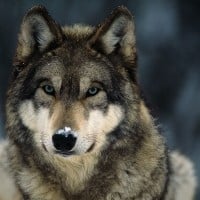

6 Arctic Fox
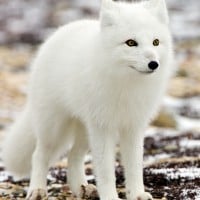 The Arctic fox (Vulpes lagopus), also known as the white fox, polar fox, or snow fox, is a small fox native to the Arctic regions of the Northern Hemisphere and common throughout the Arctic tundra biome. It is well adapted to living in cold environments, and is best known for its thick, warm fur that is also used as camouflage. It has a large and very fluffy tail. In the wild, most individuals do not live past their first year but some exceptional ones survive up to 11 years. Its body length ranges from 46 to 68 cm (18 to 27 in), with a generally rounded body shape to minimize the escape of body heat. ...read more.
The Arctic fox (Vulpes lagopus), also known as the white fox, polar fox, or snow fox, is a small fox native to the Arctic regions of the Northern Hemisphere and common throughout the Arctic tundra biome. It is well adapted to living in cold environments, and is best known for its thick, warm fur that is also used as camouflage. It has a large and very fluffy tail. In the wild, most individuals do not live past their first year but some exceptional ones survive up to 11 years. Its body length ranges from 46 to 68 cm (18 to 27 in), with a generally rounded body shape to minimize the escape of body heat. ...read more.
 The Arctic fox (Vulpes lagopus), also known as the white fox, polar fox, or snow fox, is a small fox native to the Arctic regions of the Northern Hemisphere and common throughout the Arctic tundra biome. It is well adapted to living in cold environments, and is best known for its thick, warm fur that is also used as camouflage. It has a large and very fluffy tail. In the wild, most individuals do not live past their first year but some exceptional ones survive up to 11 years. Its body length ranges from 46 to 68 cm (18 to 27 in), with a generally rounded body shape to minimize the escape of body heat. ...read more.
The Arctic fox (Vulpes lagopus), also known as the white fox, polar fox, or snow fox, is a small fox native to the Arctic regions of the Northern Hemisphere and common throughout the Arctic tundra biome. It is well adapted to living in cold environments, and is best known for its thick, warm fur that is also used as camouflage. It has a large and very fluffy tail. In the wild, most individuals do not live past their first year but some exceptional ones survive up to 11 years. Its body length ranges from 46 to 68 cm (18 to 27 in), with a generally rounded body shape to minimize the escape of body heat. ...read more. Also known as the white fox, polar fox, or snow fox. It preys on lemmings, voles, ringed seal pups, fish, waterfowl, and seabirds
7 Grizzly Bear
 The grizzly bear less commonly called the silvertip bear, is any North American morphological form or subspecies of brown bear.
The grizzly bear less commonly called the silvertip bear, is any North American morphological form or subspecies of brown bear.
 The grizzly bear less commonly called the silvertip bear, is any North American morphological form or subspecies of brown bear.
The grizzly bear less commonly called the silvertip bear, is any North American morphological form or subspecies of brown bear. Its scientific name is actually North American brown bear.
They are normally omnivores as their diets consist of both plants and animals.
8 Cougar
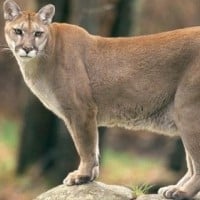 The cougar, also commonly known as the mountain lion, puma, panther, or catamount, is a large felid of the subfamily Felinae native to the Americas.
The cougar, also commonly known as the mountain lion, puma, panther, or catamount, is a large felid of the subfamily Felinae native to the Americas.
 The cougar, also commonly known as the mountain lion, puma, panther, or catamount, is a large felid of the subfamily Felinae native to the Americas.
The cougar, also commonly known as the mountain lion, puma, panther, or catamount, is a large felid of the subfamily Felinae native to the Americas. The biggest cat in North America; primary food sources are
ungulates, particularly deer; also rodents.
9 Pike


A species of carnivorous fish
10 Wolverine
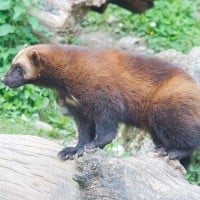 The wolverine, Gulo gulo, also referred to as the glutton, carcajou, skunk bear, or quickhatch, is the largest land-dwelling species of the family Mustelidae.
The wolverine, Gulo gulo, also referred to as the glutton, carcajou, skunk bear, or quickhatch, is the largest land-dwelling species of the family Mustelidae.
 The wolverine, Gulo gulo, also referred to as the glutton, carcajou, skunk bear, or quickhatch, is the largest land-dwelling species of the family Mustelidae.
The wolverine, Gulo gulo, also referred to as the glutton, carcajou, skunk bear, or quickhatch, is the largest land-dwelling species of the family Mustelidae. It closely resembles a small bear
BAdd New Item